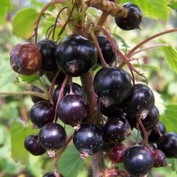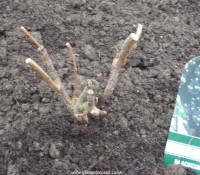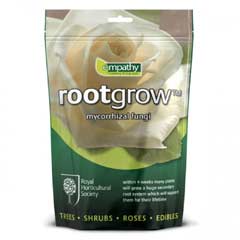Choosing and growing blackcurrant varieties
In the rush and excitement of setting up a new allotment, it may be tempting to buy the inexpensive blackcurrant bushes you see in a market or bargain shop, especially if you have previously seen bushes at garden centres at high prices. However, you will have the bushes in your plot for many years, and buying a weedy or unnamed plant is a false economy. In fact.plants have been seen offered for sale at one shop in the centre of Ashford which were not only stone dead, but had been so since the previous winter! This has happened more than once since the shop opened, so we have no compunction about saying 'Don't buy plants from the 99p stores'. Plants at markets may be healthy imports from Holland, but are either unnamed or are bog-standard varieties. If you want good quality plants without paying through the nose, buy them bare-root, during the winter, from a reputable mail-order (and internet supplier) like R.V Roger, who have a fantastic range of plants and offer expert service.
|
Choosing varieties when faced with a large list like Roger's may be daunting. Fortunately the RHS did a trial of blackcurrant varieties in 2013. They only trialled a few varieties but their findings were as follows:
|
Click on the picture (left) to go to R V Roger's page with 13 different blackcurrant varieties. R V Roger is an long-established firm in Yorkshire which will give you honest information and not try to blind you with marketing flummery.
|
Ben Connan - midseason, compact, heavy yielding, but acidic so best for jams and cooking
Big Ben - early, best all-round variety, with good flavour both fresh and cooked; large berries.
Ben Hope - midseason, resistant to gall mite. Heavy crops of sharp fruit, the flavour not outstanding.
Ben Lomond - midseason, subject to mildew attack! Poor yields, not a good choice at all.
Ben Sarek - Very compact. Acidic fruit needing extra sugar. The 1993 AGM was actually withdrawn as the fruit can be fiddly to pick, but still good for small plots.
Ben Tirran - late. Compact and upright, flavour not bad.
Ebony - earliest ripening, large berries, but not the best flavour of all.
Curiously, this advice contradicts information given elsewhere on their website - but this would seem to be more up-to-date. R V Roger stocks a lot more than these varieties and their website gives details too.
Big Ben - early, best all-round variety, with good flavour both fresh and cooked; large berries.
Ben Hope - midseason, resistant to gall mite. Heavy crops of sharp fruit, the flavour not outstanding.
Ben Lomond - midseason, subject to mildew attack! Poor yields, not a good choice at all.
Ben Sarek - Very compact. Acidic fruit needing extra sugar. The 1993 AGM was actually withdrawn as the fruit can be fiddly to pick, but still good for small plots.
Ben Tirran - late. Compact and upright, flavour not bad.
Ebony - earliest ripening, large berries, but not the best flavour of all.
Curiously, this advice contradicts information given elsewhere on their website - but this would seem to be more up-to-date. R V Roger stocks a lot more than these varieties and their website gives details too.
More for your money with blackcurrants
Unlike gooseberries or redcurrants, which should be grown on a 'leg' - like a little trunk to lift the branches off the ground - blackcurrants need to be planted deep, with the point where the branches separate buried a couple of inches or more down. This will encourage the bush to produce lots more branches, which is what you want with a blackcurrant.
|
After you have planted your black currant (and you haven't forgotten proper soil preparation, have you - dug and forked over well, all weed roots removed, a good dollop of well-rotted manure well mixed in?) then you prune off the branches which are left sticking up out of the ground back to about 4" from soil level. You will lose the first year's crop, but ensure strong growth and good crops in the years to come. Don't wimp out on this step, if you don't prune, the crop you get the first year will be miserable, as the bush hasn't made proper roots yet. And you'll damage your crops for years to come.
|
However, DO NOT WASTE them bits wot you have cut orf!!! Trim them to about 10" (28cm in the new money, but the length isn't exact) and pop them in the ground in a well-drained, slightly shady spot. Blackcurrant cuttings are notoriously easy to root and, unless you are very unlucky, every shoot will make you a new bush, as good as the one you've just bought in a couple of years' time.
Useful tips for growing in Kent
Any gardening book will give you info on aftercare - that all-important pruning, and the fact that blackcurrants are notoriously greedy, loving a good mulch with manure. Kent is a dry county and blackcurrants also like a lot of water. Building up a good root system as quickly as possible, and keeping the plants from getting too dry when they are bearing fruit, are both vital.
We would strongly recommend that you do two little extra things which will help both to get you off to a good start, and to keep your bushes happy for years to come.
First, when preparing the soil, mix in over an area about 5-6ft across, and a good spade's spit down, those water-retaining gel crystals which you buy for hanging baskets. These last for years in the soil - in fact they only break up, they never really go away - and will help keep the moisture down there, whether from rain of from your watering can, where the roots really need it.
We would strongly recommend that you do two little extra things which will help both to get you off to a good start, and to keep your bushes happy for years to come.
First, when preparing the soil, mix in over an area about 5-6ft across, and a good spade's spit down, those water-retaining gel crystals which you buy for hanging baskets. These last for years in the soil - in fact they only break up, they never really go away - and will help keep the moisture down there, whether from rain of from your watering can, where the roots really need it.
|
Secondly, use 'Root-grow' when planting. This beneficial preparation of mycorrhizal fungi creates a second, infinitely small but incredibly efficient, root system which works symbiotically with your plant. Click on the picture to go to a website which has a good explanation of how Rootgrow works. Search the web or check out your local garden centre to get the best price. Rootgrow helps when planting on all woody plants, and even on those like paeonies that usually take a long time to establish, so it is well worth having in your shed!
|
If you need to water in dry weather, don't sprinkle the plants or use a hose with spray nozzle. Fill a big watering can and drench the roots thoroughly. This way the water will soak down to a deeper level and last for days, long after surface watering has evaporated off.




